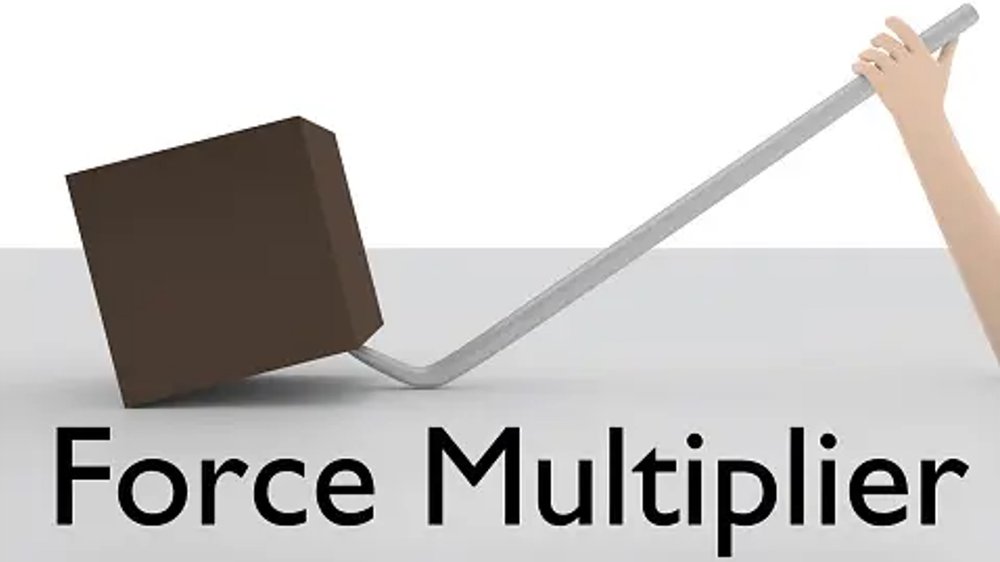Now that we are fans of the Science of Learning, we thought we would take a look and see if there was some type of magic bullet, something that could increase the overall effect of the Science of Learning – something that could raise the bar and make what we know through the Science of Learning even more effective.
A force multiplier, if you will.
Something that can make everything we do bigger, more, better, nicer. If this were a toothpaste commercial, we would be saying, “New, whiter, brighter.” But since it is a learning article, let’s just say, “Smarter!” That should sum it up nicely. In the Science of Learning, a force multiplier will make students smarter.
Is that even possible? Most definitely.
Before we explain how a force multiplier can make learning bigger, more, better and nicer, let’s take a look at the learning process as educators understand it today, seen through the lens of the Science of Learning.
Understanding New Ideas:
Effective learning involves connecting new concepts to existing knowledge. Analogies aid this process, but they must be elaborated on. Overloading working memory impedes learning; worked examples and diverse modalities help. Content should be explicit, paced, and based on mastery, not age-related stages.
Learning and Retaining Information:
Retrieval practice enhances memory. Assign tasks requiring explanation or meaningful organization. Stories and mnemonics aid understanding. Spaced practice, emphasizing memory retrieval, and interleaved practice of different content types improve learning.
Problem Solving:
Long-term memory of essential facts aids problem-solving. Teaching age-appropriate sets of facts is crucial. Effective feedback focuses on tasks, is explanatory, and aims at improvement.
Transfer of Learning:
Transfer requires understanding the context and underlying structure of a problem. Teachers can ensure background knowledge, use varied examples, and encourage the identification of problem-solving steps.
Motivation to Learn:
Beliefs about intelligence impact motivation. Praising effort and encouraging goal-setting fosters improvement-focused motivation. Self-determined motivation leads to better outcomes than controlled motivation. Teachers influence motivation through various factors related to rewards or praise.
Common Misconceptions:
Dispel common misconceptions: there are no fixed learning styles, humans use their brains fully, and the right/left-brained notion is inaccurate. Novices and experts can think similarly, and cognitive development is not fixed by age-related stages. Teachers should recognize and address these misconceptions in cognitive science.
Now, adding to that, let’s look at the basics of cognitive science – and how cognitive science added to our understanding of the learning process can become that force multiplier.
The Basics of Cognitive Science
In its most basic language, cognitive science is the understanding of cognitive skills working in the brain, and how these cognitive skills all work together to increase the ability of the brain to recognize, process, integrate and apply knowledge. Cognitive skills also include the processes that help us learn and think, solve problems, collaborate and create.
Reception
Reception is the initial step in the learning sequence and involves taking in information through our sense: sight, hearing, smell, taste, and touch.
The enormous amount of information available to our senses is too much for our brains to manage, so our brains decide which information is important and relevant enough to be processed further, and then discards the vast majority that isn’t relevant or important.
Our brains take just fractions of a second to determine what is relevant and what to discard, and we are not even aware of it happening; this processing is all nonconscious. To do this, we depend on cognitive skills such as the ability to efficiently gather visual and auditory inputs and various attention skills that enable us to focus on certain stimuli while screening out others.
Information is rapidly compared, sorted, organized, and then filtered to enable relevant information to flow through to other processes.
Perception
At the next stage of the learning sequence, information selected in the reception stage is further processed to identify and interpret it. This requires retrieving stored information from memory and integrating it with the new information to ascribe meaning to the incoming information. Here, we must also put visual and auditory information together to create a meaningful whole, keep items in a sequence and understand where things are in space and time relative to other things. Again, these processes occur within fractions of a second, up to a few seconds, and are performed nonconsciously.
Memory
Memory is essential in all phases of information processing and is integral to any ability to manipulate information, compare, comprehend, and learn. In fact, if we can’t remember something, we can’t really be said to have learned it.
Memory skills range from immediate to long-term, depending on the duration of time information is stored, as well as the physical brain structures used to retrieve it.
The only stage at which we are conscious of the information is when we are holding it and manipulating it in working memory.
Working Memory refers to our conscious processing and the ability to hold information actively in mind while we think about it. Just as our brains screen and discard most information at the reception stage, much of the information held in sensory memory or immediate short-term memory is then discarded. It is only if we decide to think about information, holding it and manipulating it in working memory that it has a chance to end up being stored in long-term memory.
Direction
Working memory is one of a special class of cognitive skills, referred to as executive functions.
Executive functions are the directive capacities of our minds, so we call this stage of cognitive processing Direction.
The other two executive functions are: Inhibitory control, essential for self-regulation and Cognitive flexibility, which is how we reorient our thoughts when the rules of the world around us change, when we look at things from different perspectives or when we shift from an external focus to internal reflective thinking. Executive functions are often likened to the conductor of the orchestra who directs all of the instruments to produce a coordinated musical experience. Like the conductor of an orchestra, our executive functions direct what is going on in our brains to enable us to make decisions and take actions.
Thinking
The thinking stage of processing is the stage at which we use cognitive skills like analysis and complex reasoning. These skills, which often read like lists of 21st Century skills, are also called higher order executive functions.
The result of the thinking stage is some kind of output and this is the stage at which we achieve comprehension, make decisions, plan for the future, solve problems and take actions.
Non-Linear Integration of Skills
While all of these stages of processing seem like discrete steps or functions, our brains do not process information in a linear fashion. It is our brains’ ability to coordinate all these processes together that accounts for learning and intelligence. Cognitive skills are the foundation for learning, and cognitive strengths and weaknesses impact the learning process.
It has been estimated that cognitive skills account for 50 percent of the variance in academic performance, greater than factors such as instructional quality or focus on achievement.
Cognitive Science Led to Cognitive Training
Cognitive Science, the understanding of cognitive skills working in the brain, and how these cognitive skills all work together to increase the ability of the brain to recognize, process and integrate and apply knowledge, led to cognitive training – increasing cognitive skills, which increases the brain’s ability to learn and think, solve problems, collaborate and create – and in essence, making us smarter.
Cognitive training – also called brain training – involves engaging in activities designed specifically to strengthen one or more cognitive skills, the mental processes our brains use to think and learn. Some cognitive training programs focus on individual cognitive skills, while others are more comprehensive and integrated. Cognitive training programs may use computer-based exercises, physical movement, paper-and-pencil activities, manipulatives or other aids such as playing cards or a combination of multiple training approaches.
Although cognitive training often has as its primary purpose improving one’s ability to drive learning and behavior, it is different from the learning experiences typically provided in formal education, which are not specifically designed to build learning skills. Formal education in school focuses on developing academic skills and knowledge, rather than the processes our brains use to take in, organize, store, retrieve and apply information. Much formal education involves direct instruction, that is, a teacher explaining to a student how to do something. Cognitive skills are not amenable, generally speaking, to direct instruction, since they operate at a nonconscious level. For example, one cognitive skill often addressed in cognitive training is working memory, the ability to hold information in mind while one thinks about it. Trying to explain to someone else how to hold more information in their conscious processing is not effective, yet working memory can be expanded with comprehensive and integrated cognitive training. Trying to explain to someone how to process information faster doesn’t work, but processing speed can often be improved, again with the right kind of cognitive training.
Cognitive training has a lot in common with physical training and physical exercise. In a physical training program, we build strength, speed, flexibility and stamina, all aspects of our bodies’ capacity for physical activity. In a cognitive training program, we build and strengthen the brain’s capacity for mental activity.
The science of physical training emerged from the concepts and techniques of physical therapy and continues to evolve as the science of human physical performance progresses. The science of cognitive training likewise has evolved from therapy for various cognitive processes, such as speech and vision therapy, as well as from the research on cognitive assessment and the neuroscience of learning and has evolved into mental fitness.
Some cognitive training programs focus on one specific skill, such as a speed of processing training program or working memory training. The most effective programs, in terms of impact and sustainability, lasting effect and transfer to other activities are those that encompass a broader set of skills and address them in a comprehensive integrated way.
Force Multiplication Now Lessons the Challenges
Force Multipliers are tools that help you amplify your effort to produce more output. A jackhammer is an example of a force multiplier. Investing in force multipliers means that you'll get more done with less effort.
Force-multipliers are tools, elements, or a combination of factors that dramatically increase the effectiveness of a component or group in such a way that they supersize the outcomes and accomplish greater output, often in lieu of additional funding or time.
Now, think of comprehensive integrated cognitive skills training as learning’s force multiplier.
Cognitive processes are not subject-specific. They are not domain-specific. We all have cognitive strengths and cognitive weaknesses, and those strengths and weaknesses influence everything we do. They make it harder or easier to learn to read. They make math computations a snap or a drag. They make critical thinking fluid or opaque, and they can positively affect attitude and behavior.
Think about all the other cognitive processes that are part of the learning process – reasoning skills, executive functions, processing speed, and others, woven together into the complexity that is each student’s learning capacity.
Some cognitive training programs focus narrowly on a few cognitive skills, assuming that working on one particular skill at a time will produce a great effect; however, modern brain science indicates that this is not the case. More effective programs reflect the principle that the brain is a highly comprehensive integrated systemic organ and that skills must not only be strong but also work together. Recent research provides greater support for the brain as a comprehensive integrated system that must be trained in a comprehensive integrated way.
All students (and their teachers, for that matter) have cognitive strengths and weaknesses. Developing their cognitive capacity in a comprehensive and integrated manner is a vital step in helping students become their best selves. This is what cognitive assessment and comprehensive integrated training allows us to do for our students. Sophisticated, nationally normed assessments can identify the strengths and weaknesses of the cognitive skills within a student’s learning process. This allows us to prescribe an comprehensive integrated cognitive skills training program to strengthen the process down to a cognitive skills level, and reinforce the learning capacity of the student, in essence making them smarter.
According to Gregg Goewert, principal of Urey Middle School, “Faculty and Staff use cognitive assessment data to help them (and their students) understand how students learn best. In addition to using cognitive assessment data, students participated in cognitive skills training to help strengthen weaker cognitive skills and further strengthen skills that were already strong. As they built their learning capacity, student self-confidence increased, helping them better manage stress and achieve dramatically improved levels of academic performance.”
When you prescribe an comprehensively integrated cognitive skills training program, everything becomes more in focus. ELA, Math, Science, Humanities, athletics, and even social-emotional competence will no longer be quite the challenge that it once was, and increased confidence and reduced stress are the natural byproducts of the process.
About the authors

Betsy Hill is President of BrainWare Learning Company, a company that builds learning capacity through the practical application of neuroscience. She is an experienced educator and has studied the connection between neuroscience and education with Dr. Patricia Wolfe (author of Brain Matters) and other experts. She is a former chair of the board of trustees at Chicago State University and teaches strategic thinking in the MBA program at Lake Forest Graduate School of Management where she received a Contribution to Learning Excellence Award. She received a Nepris Trailblazer Award for sharing her knowledge, skills and passion for the neuroscience of learning in classrooms around the country. She holds a Master of Arts in Teaching and an MBA from Northwestern University. Betsy is co-author of the new book, “Your Child Learns Differently, Now What?”

Roger Stark is Co-founder and CEO of the BrainWare Learning Company. Over the past decade, he championed efforts to bring the science of learning, comprehensive cognitive literacy skills training and cognitive assessment, within reach of every person, and it all started with one very basic question: What do we know about the brain? From that initial question, Roger Stark pioneered the effort to build an effective and affordable cognitive literacy skills training tool, based on over 50 years of trial and error through clinical collaboration. He also led the team that developed BrainWare SAFARI, which has become the most researched comprehensive, integrated cognitive literacy training tool delivered online anywhere in the world. For more, follow BrainWare Learning on Twitter @BrainWareSafari. Roger is co-author of the new book, “Your Child Learns Differently, Now What?”











